Ivan Čuk
Foreword
Sunčica Delaš Kalinski, Almir Atiković, Igor Jelaska, Mirjana Milić
PERFORMANCE ANALYSIS OF FEMALE GYMNASTS’ VAULT IN ELITE COMPETITIONS FROM 2008 TO 2015
Muhamed Tabaković, Almir Atiković, Elvir Kazazović, Senad Turković
EFFECTS OF ISOKINETIC RESISTANCE TRAINING ON STRENGTH KNEE STABILIZERS AND PERFORMANCE EFFICIENCY OF ACROBATIC ELEMENTS IN ARTISTIC GYMNASTICS
George Dallas, Kostas Dallas
EFFECTS OF ANKLE JOINT INJURIES ON BALANCE IN MALE AND FEMALE GYMNASTS
Nebojša Trajković, Dejan Madić, Goran Sporiš, Aleksandra Aleksić-Veljković, Kamenka Živčić-Marković
IMPACT OF GYMNASTICS PROGRAM ON HEALTH-RELATED FITNESS IN ADOLESCENT PUPILS
Matej Majerič, Janko Strel, Marjeta Kovač
THE IMPORTANCE OF DIFFERENT EVALUATION METHODS IN PHYSICAL EDUCATION – A CASE STUDY OF STRADDLE VAULT OVER THE BUCK
Maria-Raquel G. Silva, Paulo Barata
ATHLETES AND COACHES’ GENDER INEQUALITY: THE CASE OF THE GYMNASTICS FEDERATION OF PORTUGAL
Anton Gajdoš
Short Historical Notes VI
Christoph Schärer, Klaus Hübner
ACCURACY OF PREDICTION OF MAXIMUM RESISTANCE AT INCREASED HOLDING TIMES BASED ON A THREE SECONDS MAXIMUM STATIC STRENGTH TEST OF THE THREE MAIN STRENGTH ELEMENTS ON RINGS
Ivan Čuk
Foreword
A few days ago SCOPUS published new values for SNIP, IPP and SJR for 2015. In SNIP The Science of Gymnastics has been upgraded and placed in the second quarter of journals. It is a great improvement! In IPP and SJR, we remain in the third quarter. I met and had talks with Hardy Fink, director of FIG Academy, and Prof. Keith Russell, Chairman of the FIG Scientific Commission. We all agree that we need a history section for our sport. Professor Anton Gajdoš, has been writing 'Historical notes' for our journal about important persons in our sport. But there are many important historic documents that should also be made public, such as documents relating to the foundation of FIG and national federations; how and when national federations entered FIG; documents about previous championships, medals, cups, diplomas; what were the requirements for compulsory and optional exercises and how they looked, etc.
In our previous issue, an error occurred in the names of the authors of article Participation of the Pan-American Gymnastics Union in the 2011 World Gymnaestrada, for which we apologise. The Brazilian researchers lead by Elizabeth Paoliello were Eliana de Toledo, Daniela Bento Soares, Tabata Larissa Almeida, Cintia Moura, Andrea Desiderio, Michele Viviene Carbinatto, Carolina Gontijo Lopes, Bruno Barth Pinto Tucunduva and Marco Antonio Coelho Bortoleto. When sending an article, please make sure that the names of authors in ScholarOne are the same as in those in the cover letter to prevent such errors in the future.
In August, the Olympic Games in Rio de Janeiro in Brazil will start with our sports, artistic gymnastics, rhythmic gymnastics and trampolining. We hope our sports will continue to be successful in the Olympic family and hopefully some other disciplines can join them in the near future (sports aerobics, acrobatics). With enthusiastic participation of athletes, coaches, managers, researchers, scientists and media support we can succeed.
In this issue there are seven articles. Their authors are from Croatia, Bosnia and Herzegovina, Switzerland, Serbia, Greece, Slovenia and Portugal. Topics are very diverse, including competition result analysis, strength development, injuries in relation to the balance abilities, health gymnastics, gymnastics knowledge evaluation and differences in gymnastics participants' gender.
In line with the practice of other journals, from this year onward page numbers continue from the first issue to the third one rather than starting with page one in each new issue.
Just to remind you, if you quote the Journal: its abbreviation on the Web of Knowledge is SCI GYMN J.
I wish you pleasant reading and a lot of inspiration for new research projects and articles.
Sunčica Delaš Kalinski, Almir Atiković, Igor Jelaska, Mirjana Milić
PERFORMANCE ANALYSIS OF FEMALE GYMNASTS’ VAULT IN ELITE COMPETITIONS FROM 2008 TO 2015
Vault is an apparatus that slightly differs from other in women’s artistic gymnastics in the way of judging, duration of performance, but also in the requirements for certain biomotor abilities of the competitors. Accordingly, the question of number of competitors in the Vault Qualifications arises. Of all the major competitions in the period from 2008 to 2015 only at the competitions that were Individual All-Around Finals and Individual Event Finals (WC2009 and WC2013) a high percentage of Vault Qualifiers (WC2009 = 81.03%; WC2013 = 90.90%) has been identified. At other competitions (OG2008, WC2010, WC2011, QOG2012, OG2012, WC2014, WC2015) only approximately 20% of the elite competitors competed Vault Qualifications. Furthermore, due to identification of the impact of Competitor type (Vault Qualifiers or All-Around competitors), Competition (OG2008, WC2009, WC2010, WC2011, QOG2012, OG2012, WC2013, WC2014, WC2015) and their interaction with vaults Difficulty Scores, Execution Scores and Total Scores between-between 2*9 factorial ANOVA was applied. Finally, it was concluded that biomotor skills and competitors’ selected tactics probably generated the obtained significant differences. The results should be guidelines in planning and programming of training sessions for female elite competitors who aspire towards the Vault Finals.
Keywords: female, artistic gymnastic, vault, development.
Muhamed Tabaković, Almir Atiković, Elvir Kazazović, Senad Turković
EFFECTS OF ISOKINETIC RESISTANCE TRAINING ON STRENGTH KNEE STABILIZERS AND PERFORMANCE EFFICIENCY OF ACROBATIC ELEMENTS IN ARTISTIC GYMNASTICS
The aim of this study was to examine whether additional training protocol of isokinetic training results in increased biomechanical values of certain parameters and whether it increases functional correlation between speed and strength leading to improved performance of acrobatic elements in floor exercises. Additional training protocol, which lasted for one semester, was performed on Biodex 3 apparatus (60°·s–1). Examinees participating in this research were (N = 80) male students from Faculty of Sport and Education (mean age, 19.8 ± 1.7 year; weight, 75.2 ± 2,9 kg; height 179.7 ± 6.4 cm). Control group (N = 40), between two measurements, conducted only regular practical teaching program of artistic gymnastics. Experimental group (N = 40), besides regular practical teaching program of artistic gymnastics, also had additional program of isokinetic practice on Biodex 3 apparatus. Experimental group showed obvious structural changes that can be dominantly registered through variables assessing the maximum strength of the dynamic knee stabilizers (the maximum moment of force, overall work and average strength) and reciprocal relationship between agonist and antagonist muscles. In variables assessing the performance of elements of floor exercises in artistic gymnastics we obtained statistically significant differences in elements requiring changes of the maximum strength of the dynamic knee stabilizers: dive roll, back handspring, salto forward and backward tucked.
Keywords: isokinetic, peak torque, power, work, acrobatic elements.
George Dallas, Kostas Dallas
EFFECTS OF ANKLE JOINT INJURIES ON BALANCE IN MALE AND FEMALE GYMNASTS
Gymnastics is a sport where there always exists a real and present danger of physical injury. Athletic injury, whether temporary or permanent, is a painfully disruptive and uncontrollable interruption in a gymnast's career. Injuries can have profound negative consequences on a gymnast’s balance, with lower limbs injuries constituting the majority of these injuries. The purpose of this study was to assess differences in postural stability between high level male and female artistic gymnasts who suffered ankle sprain injuries (ASI) on either or both legs in the past. Ten female (age = 16.66 ± 3.20 years, mass = 47.30 ± 8.00 kg, height = 158.00 ± 5.75 cm) and ten male gymnasts (age = 22.30 ± 1.77 years, mass = 62.00 ± 3.33 kg, height = 168.50 ± 3.03 cm) volunteered to participate in this single visit study. Participants were measured for Limits of Stability variables (Reaction Time [RT]; Center of Gravity Velocity [MVL]; Directional Control [DCL]; End Point Excursion [EPE]; Maximum Excursion [MXE]) to examine the effect of ASI on postural stability. Limits of Stability (LOS) test were used to examine postural stability of gymnasts using the EquiTest Computerized Dynamic Posturography system. Results indicated that females had significantly less ASI than male gymnasts and recorded significantly lower values in Reaction Time and higher values in Movement Velocity during LOS test. In conclusion, the number of past ASI influence postural control as the musculo-tendinous changes around the ankle lead to a reduction of proprioceptive information and may contribute to the deficient postural control mechanisms after injury. Furthermore, postural control may be affected even after acute ASI resolution
Keywords: Limits of Stability, Reaction Time, End Point Excursion, Maximum Excursion.
Nebojša Trajković, Dejan Madić, Goran Sporiš, Aleksandra Aleksić-Veljković, Kamenka Živčić-Marković
IMPACT OF GYMNASTICS PROGRAM ON HEALTH-RELATED FITNESS IN ADOLESCENT PUPILS
The aim of this study was to determine the effects of gymnastics program in school on health related fitness in adolescent pupils. The study involved 58 adolescent pupils (14.82±0.44 years) attending the first grade at high school involved in a 12 week of gymnastics classes. The variables were selected within the battery of tests Eurofit, measuring abdominal strength, flexibility, aerobic fitness and upper and lower body strength, speed and agility. The results showed average initial level and later dynamic increase in the physical fitness of the participants. Pre-test to post-test values showed significant improvements in all tested variables (p<0.05), except for the 4x10m test. Therefore, participation in gymnastics must be recommended as a positive foundational activity for school-aged children, from early childhood to adulthood. Additionally, the results can provide useful information in optimizing the training loads of pupils involved in gymnastic training throughout Physical Education classes.
Keywords: effects, PE classes, training, physical fitness.
Matej Majerič, Janko Strel, Marjeta Kovač
THE IMPORTANCE OF DIFFERENT EVALUATION METHODS IN PHYSICAL EDUCATION – A CASE STUDY OF STRADDLE VAULT OVER THE BUCK
This article presents a study of three different evaluation methods for one of the most frequently evaluated skills in physical education: straddle vault over the buck. The sample of measured subjects included 193 13-year-old boys, whose video-recorded performances were evaluated by three evaluators. We analysed the differences in the reliability, objectivity and time efficiency of three different evaluation methods. The calculation of Cronbach’s alpha coefficients and analysis of the variance has been used. The analysis of reliability revealed that the combined evaluation method (alpha: 0.928) was the most reliable, the holistic method was less reliable (alpha: 0.879), and the least reliable was the analytical evaluation method (alpha: 0.833). The analysis of objectivity showed that the analytical evaluation method was the most objective (alpha: 0.854), the combined method was less objective (alpha: 0.791), and that the holistic evaluation methods were the least objective method (alpha: 0.778). The analysis of time efficiency revealed that the least time had been spent in the holistic evaluation method and much more in analytical and combined evaluation method. Analysis of the three evaluators, using three different evaluation methods showed no statistically significant differences (p=0.638) between the holistic and combined evaluation method. In contrast, statistically significant differences have been found between the holistic and analytical method (p=0.000) and combined and analytical method (p=0.000). According to the analysis, we can conclude that all three evaluation methods are appropriate for the evaluation of pupils’ knowledge in physical education.
Keywords: Physical education, gymnastics, test task, evaluation guidelines.
Maria-Raquel G. Silva, Paulo Barata
ATHLETES AND COACHES’ GENDER INEQUALITY: THE CASE OF THE GYMNASTICS FEDERATION OF PORTUGAL
The aim of this study was to analyze the gender-participation among Portuguese gymnasts and Portuguese coaches, according to gymnastics’ disciplines and geographical areas of Portugal. An individual-authorized data base of all national gymnasts involved in the National School of Gymnastics of the Gymnastics Federation of Portugal (Federação de Ginástica de Portugal) during three athletic seasons, namely 2012/2013, 2013/2014 and 2014/2015. Data from coaches was only available for the season of 2012/2013. In the athletic season of 2012/2013, from a sample of 14742 gymnasts, 81.2% were female and only 18.7% were male (P< 0.01). Similar results were found in the next two seasons as follows: 83.2% were female and 16.7% were male in 2013/2014 and 84.9% were female and 15.1% were male in 2014/2015. Significantly gymnasts-gender differences (P<0.01) were observed for all disciplines. In RG, WAG and MAG no differences between genders were observed due to the exclusive sport participation of female or male gymnasts, respectively. The same tendency of gymnasts’ genderparticipation was observed for coaches; thus, the majority of Portuguese coaches (57.7%) was female and 42.3% were male. The inclusion of gymnastics in sport events can increase female participation due to its characteristics.
Keywords: Gender-participation, gymnastics, disciplines, athletes, coaches.
Anton Gajdoš
Short Historical Notes VI
We introduce USA Men team for OG 1964, Ladislav Vacha and Sergej Anatolijevič Alekperov.
*
New Books
Parallel bars by Ivan Čuk, Istvan Karacsony
Gymnastics Performance and Motor Learning: Principles and Applications by Editors: Thomas Heinen (University of Hildesheim, Germany), Ivan Čuk (University of Ljubljana, Slovenia), Ruben Goebel (Qatar University, Qatar), Kostas Velentzas (Bielefeld University, Germany)
Christoph Schärer, Klaus Hübner
ACCURACY OF PREDICTION OF MAXIMUM RESISTANCE AT INCREASED HOLDING TIMES BASED ON A THREE SECONDS MAXIMUM STATIC STRENGTH TEST OF THE THREE MAIN STRENGTH ELEMENTS ON RINGS
On rings in men’s artistic gymnastics, a high degree of relative maximum strength is crucial to present up to seven strength elements in the required quality in the routine. To increase this specific strength and strength endurance the coaches often prolong the holding times of those elements by using the devices counterweight and additional weight in training. The purpose of this study was to investigate the predictability of the maximum resistance (MR) (minimal counterweight/maximum additional weight) at five and seven seconds holding times based on the MR at three seconds of the elements Iron Cross (C), Support Scale (SS) and Swallow (S) and to provide coaches with a reliable conversion table that predicts the individual training weights at different holding times. Ten male gymnasts of the Swiss National Team performed a specific static MR-Test (three, five and seven seconds holding time) of the elements C, SS and S. The results showed a significant decrease in MR as holding time increased (t-Test: p < 0.001). The standard error of estimate (SEE) and explained variance (R2) revealed that the prediction of MR at five seconds (SEE 0.52 kg to 1.03 kg, R2 0.92 to 1.00) was more accurate than at seven seconds holding time (SEE 0.95 kg to 2.08 kg, R2 0.88 to 0.98). Based on the linear regression equations, a useful conversion table was established that predicts the MR at five and seven seconds holding time based on the three seconds MR at each of the tested elements. Keywords: artistic gymnastics, rings, strength, swallow, cross, support scale.







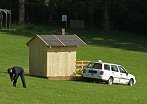


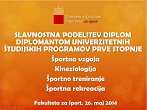


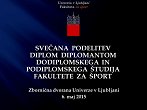



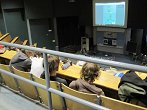


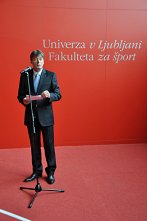
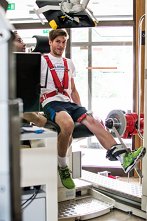

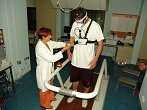










.png)